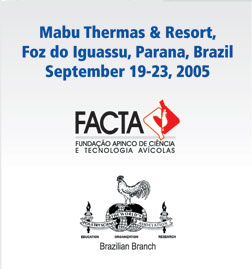| |
Contributed
Papers: Oral Presentations
Vaccines
Selection of a
precocious line of the rabbit coccidium Eimeria piriformis
and characterization of the life cycle of both the parent
strain and the precocious line
Michal Pakandl1 and Alena
Jelínková2
1Institute of Parasitology, Academy of Sciences of the
Czech Republic, Branišovská 31,
370 05 Ceské Budejovice, Czech Republic
2Faculty of Biology, University of South Bohemia, Ceské
Budejovice, Czech Republic
e-mail: pakandl@paru.cas.cz
The principal
method used to attenuate coccidian strains is selection
for early development of oocysts (precociousness). In
rabbit coccidia, the precocious lines (PL) have already
been obtained from five species (Eimeria coecicola,
E. flavescens, E. intestinalis, E. magna and E. media),
but not from E. piriformis. The aim of this work was
to select PL of E. piriformis and to characterize endogenous
development of both of original strain (OS) and PL.
SPF rabbits were inoculated with OS oocysts and the
first newly developed oocysts recovered from the intestine
were used for the infection of other rabbits. The prepatent
period (PP) was shortened after 12 passages from 194
to 170 hours and remained stable after 5 passages without
any selection pressure. Histology and transmission electron
microscopy were used to characterize the endogenous
development and oocyst morphology of PL and OS. PL oocysts
exhibited peculiar morphology. Besides refractile bodies
(RB) within sporozoites, one huge RB merged with a residual
body was present inside each sporocyst. The parasite
developed in the proximal colon and in lesser extent
in other parts of the large intestine. All stages were
seen in the epithelium of crypts. In OS, four asexual
generations preceded gamogony and, like in other rabbit
coccidia, two types of meronts were observed: meronts
of the type A that develop in polynucleate merozoites
in which endomerogony takes place, and meronts of the
type B that form uninucleate merozoites. The endogenous
development of PL was identical with that of OS except
the last merogony which was absent. This apparently
resulted in earlier appearance of gamogony and shortening
of PP. These observations of the life cycle of E. piriformis
substantially correct its descriptions made 50-60 years
ago, which have not been verified until recently. This
work was performed in cooperation with BIOPHARM, Research
Institute of Biopharmacy and Veterinary Drugs, Czech
Republic.
back | print
|
|
